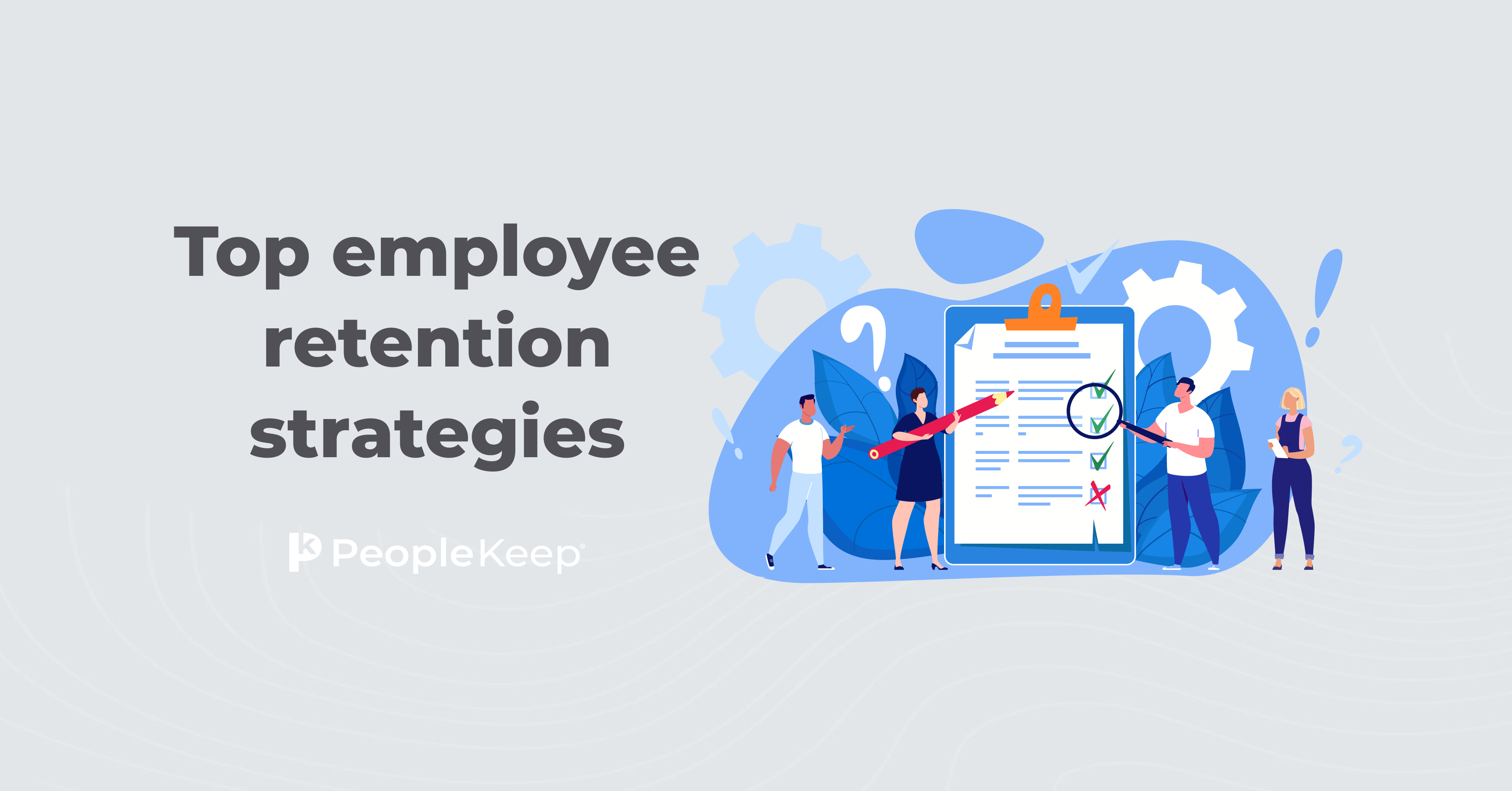How to calculate your employee retention rate
By Elizabeth Walker on March 31, 2025 at 12:00 PM
Attracting and retaining talented workers is crucial for your company’s long-term success. Losing great employees can mean losing valuable team knowledge, which can lower morale and decrease productivity.
Employee retention is a priority for many companies. But, it’s especially critical for small employers that rely on limited staff to keep their business running. Tracking your retention has several benefits. For example, you can measure the effectiveness of human resources (HR) programs, drive positive business outcomes, and develop strategies to keep employees from quitting. But first, we’ll show you how to calculate your retention rate in the article below.
In this blog post, you’ll learn:
- How to calculate your employee retention rate and why it’s a crucial metric for understanding workforce stability.
- The key differences between retention and turnover rates and how both metrics provide actionable insights into employee engagement.
- Effective employee retention strategies and best practices to create a positive workplace.
What does retention rate mean?
An employee retention rate measures the percentage of workers who stay at your company over a specific time period. Most often, employers measure their retention rate across a calendar year.
Calculating your retention rate is more than just a data point for your records. It helps you understand whether your organization provides a positive employee experience that retains a stable workforce. It also shows if your workplace environment motivates and engages your staff.
By comparing retention metrics over a set time frame, you can examine how effective you are at keeping your employees happy. If retention dips, see what your employees are missing and make the necessary adjustments to their experience.
What’s the difference between a retention rate and a turnover rate?
Many people often use turnover rate and retention rate interchangeably. But the two aren’t the same. Retention rates are the rates of employees staying. In contrast, turnover rates, also known as churn rates, are the rates at which workers leave your company. Your retention rate complements your turnover rate metric. Analyzing both together gives you a holistic view of employee transition compared to either metric alone.
Why is employee retention important for business owners?
Talented workers are your organization’s most valuable asset. Without it, you won’t be able to achieve business goals or drive key initiatives. That’s why retention should be one of your top concerns.
Almost 40 million people quit their jobs in 20241. While this is an 11% reduction from 2023 quit rates, any significant employee turnover disrupts the flow and success of a functioning business. When employees quit, they leave a knowledge gap and create more work for remaining team members.
Being familiar with your employee retention rate can help you identify problems so you can implement strategies to lower a high churn rate.
A successful employee retention rate can also lead to:
- Reduced company costs. Studies show that the average cost for replacing an employee is about 6 to 9 months’ salary. Improving retention rates can help you reduce overall turnover and hiring costs.
- Increased employee productivity. The longer employees stay at your company, the more productive they become. A high annual turnover rate can lead to reduced efficiency and lower productivity.
- Improved employee engagement. Analyzing your average employee retention rate monthly, quarterly, or annually helps you measure employee engagement. The more engaged employees you have at work, the greater your company culture will become.
Looking at internal data and comparing yearly retention rates allows you to make smarter strategic moves to help your business succeed. Some voluntary turnover is inevitable. But the happier your employees are, the less likely they will be to leave your company.
How can you calculate your employee retention rate?
Employee retention rate calculations provide a reference point when determining how your company compares to others. That’s why you should calculate it regularly to see where you stand during a period of time.
Below is an easy sample retention rate formula you can use:
(Number of employees at the end of a set time period / the number of employees at the start of a set period) x 100 = retention rate percentage.
The following table shows an example of the simple formula in practice:
|
Step |
Output |
|
Total the number of employees you employed at the beginning of the calendar year. |
39 |
|
Find the total number of these employees who remain at your organization at the end of the calendar year. |
18 |
|
Divide the number of employees at the end of the year by the number of employees at the start. |
18 / 39 = 0.46 |
|
Multiply the output by 100 to get a percentage. This is your retention rate. |
46% |
When calculating your employee retention rate, it’s important to outline a timeframe that you would like to measure. This allows you to compare it to future data of the same timeframe.
You can also separate your calculations by voluntary and involuntary turnover. This way, you can compare the percentage of terminated staff members to the percentage of employees who left your organization by choice. You can use this data to make necessary changes to your retention strategy.
What is a good employee retention rate?
Companies generally aim for an average retention rate of 90% or higher. This means the ideal average employee turnover rate is 10% or less.
According to the Bureau of Labor Statistics, the average turnover rate in 2024 was 3.3%2. This means the average retention rate is around 96.7%. But this varies by industry, location, and job type. Industries with the highest retention rates include government and finance, while the lowest rates are in the food and hospitality industry.
But a very high retention rate, like 99%, may not always be the best. Some turnover helps carve out career paths for high-performing employees within your company or allows you to attract external talent. You may also want to terminate low-performing or average employees through involuntary turnover to make your company more productive and efficient.
Best practices to improve your employee retention rate
Now that you know how to calculate your retention rate, let's talk about three ways to improve it and create a more positive work environment.
1. Value your employees and trust their judgment
You promote the value of your products to potential and current customers, so why not do the same with your employees? Expressing how valuable your employees are to you and your business can create feelings of inclusivity and pride. This can help your employees feel like working at your company is a unique opportunity.
Additionally, outstanding employees are likelier to stay at their jobs if they trust leadership and know that leadership trusts them. The more they feel like they’re helping your company grow, the more emotionally invested they become in your business’s overall success. This encourages productivity.
2. Give employees responsibility and challenge them to make a difference
Another effective retention strategy is to give your staff greater visibility and accountability over vital processes and initiatives. To start, offer them career development opportunities to grow their skills. You should also share regular updates on critical metrics like profits, revenue, and products.
The employees you’re trying to hire and retain have unique talents, skills, and drive. It’s essential to detail how their personal efforts directly and positively impact the business. A transparent company culture that is empowering, supportive, and honest will likely raise your overall employee retention rate.
3. Provide competitive compensation and reward personal contributions
Even if you implement all the strategies above, a good but underpaid employee will look to your competitors with higher salaries, especially if the position is similar to yours. To mitigate this, stay on top of industry averages and your competitors' compensation ranges. Also, don’t forget to update your benefits and perks package to remain attractive in a competitive job market.
For example, our 2024 Employee Benefits Survey found that 92% of employees value health benefits. By offering a customized health benefit, like a health reimbursement arrangement (HRA), you can keep employees satisfied with their compensation package so they won’t feel the need to search for a new job with better perks.
Successful companies also reward employees who go above and beyond. Recognizing your employees' efforts goes a long way toward improving morale and increasing company loyalty. There are many ways to show recognition, such as office parties, bonuses, and promotions. Whatever you choose, current employees need to feel that their employer appreciates them.
Conclusion
Hiring outstanding employees can be challenging. That’s why keeping them on board should be a priority. While losing some employees is unavoidable, staying mindful of the core issues that can improve retention trends can go a long way toward job satisfaction and lower churn rates.
Offering a competitive compensation package is a great way to help your business stay on track. If you want to refresh your benefits, contact us to learn how a customized HRA can meet your employees’ medical needs and improve retention efforts.
This article was originally published on July 28, 2020. It was last updated on March 31, 2025.
Check out more resources
See these related articles

Job satisfaction factors: Identifying the right benefits
Learn the key job satisfaction factors and how to identify the right benefits to boost employee morale, retention, and overall workplace happiness.

Top employee retention strategies
Looking for effective employee retention strategies? This guide provides you with proven tactics to reduce turnover and increase employee satisfaction.

Employee retention: The real cost of losing an employee
Employee turnover is costly. Discover the true cost of losing an employee and how improving retention can protect your bottom line and team performance.



